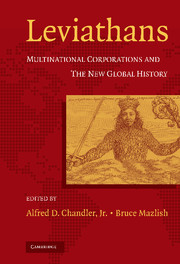Book contents
- Frontmatter
- Contents
- List of Figures and Tables
- Acknowledgments
- List of Contributors
- Introduction
- PART ONE THE SCOPE OF THE MULTINATIONAL PHENOMENON
- 1 A Primer on Multinational Corporations
- 2 Multinational Enterprise to 1930: Discontinuities and Continuities
- 3 Multinationals from the 1930s to the 1980s
- 4 Innovative Multinational Forms: Japan as a Case Study
- PART TWO CULTURAL AND SOCIAL IMPLICATIONS OF MULTINATIONALS
- PART THREE THE GOVERNANCE OF MULTINATIONALS
- Conclusion
- Index
2 - Multinational Enterprise to 1930: Discontinuities and Continuities
Published online by Cambridge University Press: 17 August 2009
- Frontmatter
- Contents
- List of Figures and Tables
- Acknowledgments
- List of Contributors
- Introduction
- PART ONE THE SCOPE OF THE MULTINATIONAL PHENOMENON
- 1 A Primer on Multinational Corporations
- 2 Multinational Enterprise to 1930: Discontinuities and Continuities
- 3 Multinationals from the 1930s to the 1980s
- 4 Innovative Multinational Forms: Japan as a Case Study
- PART TWO CULTURAL AND SOCIAL IMPLICATIONS OF MULTINATIONALS
- PART THREE THE GOVERNANCE OF MULTINATIONALS
- Conclusion
- Index
Summary
A multinational enterprise (MNE) is a firm that extends itself over borders to do business outside its headquarters country. It operates across political boundaries. It is a firm as economists define “the firm:” an allocator of resources, a producer of goods and services. Most MNEs have only one home (the headquarters country); some come to have more than one – as with Royal Dutch Shell and Unilever. Some MNEs never extend beyond a single foreign host country; others remain within a region. Some expand slowly, whereas others do so rapidly to become truly global multiproduct, multiprocess enterprises operating around the world that are horizontally and vertically integrated. By 1930, several firms had foreign direct investments on six continents.
To measure the extent of MNE activity, some scholars have looked at the percentage of business done abroad (certain early, quite small companies would qualify as substantial MNEs under this criterion). Others have considered the number of countries in which a firm does business and the absolute size of assets, sales, employment, or profits outside the headquarters country. A firm fits my definition of an MNE if it extends itself over borders, internalizing business in two or more locales within the firm that are at the time under different sovereignties. I survey the process of internationalization, that is, how firms have evolved while engaging in business outside their home country.
- Type
- Chapter
- Information
- LeviathansMultinational Corporations and the New Global History, pp. 45 - 80Publisher: Cambridge University PressPrint publication year: 2005
- 16
- Cited by



